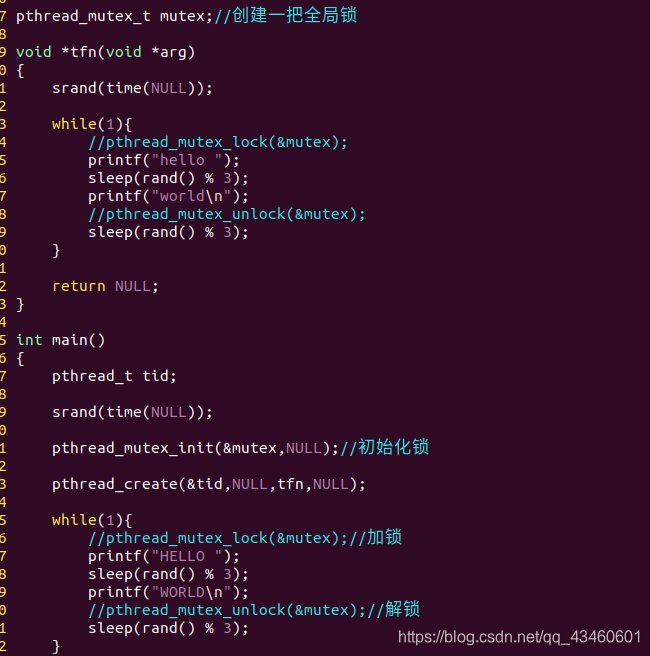线程同步
指一个线程发出某一功能调用时,在没有得到结果之前,该调用不返回。同时线程为保证数据一致性,不能调用该功能。
协同步调,对公共区域数据按序访问。防止数据混乱,产生与时间有关的错误。
互斥量(互斥锁)

pthread_mutex_t lock;//创建锁
pthread_mutex_init;//初始化
pthread_mutex_lock;//加锁
访问共享数据(stdout)
pthread_mutex_unlock;//解锁
pyhread_mutex_destory;//销毁锁
restrict 关键字:
用来限定指针变量。被该关键字限定的指针变量所指向的内存操作,必须由本指针操作。

注意事项:
尽量保证锁的粒度越小越好。(访问数据共享数据前,立即加锁。访问结束立即解锁。)
互斥锁,本质是结构体,可以看成初值为1.(pthread_mutex_init()函数调用成功)。
加锁 --操作
解锁 ++ 操作
try锁:尝试加锁,成功–。失败,返回,同时设置错误号为EBUSY。
死锁:
使用所不恰当导致的现象。
1.对一个锁反复lock。
2.两个线程各自持有一把锁,去申请不属于自己的那把锁。

进程间mutex

读写锁
锁只有一把。以读方式给数据加锁–读锁。写方式–写锁。
读共享,写独占。
写锁优先级高。


#include <stdio.h>
#include <string.h>
#include <pthread.h>
#include <stdlib.h>
#include <unistd.h>
int counter;
pthread_rwlock_t rwlock;//创建一把全局锁
void *tf_read(void *arg)
{
int i = (int)arg;
while(1){
pthread_rwlock_rdlock(&rwlock);//读锁
printf("-----------read %d:%lu:%d\n",i,pthread_self(),counter);
pthread_rwlock_unlock(&rwlock);//解锁
usleep(2000);
}
return NULL;
}
void *tf_write(void *arg)
{
int t;
int i = (int)arg;
while(1){
pthread_rwlock_wrlock(&rwlock);
t = counter;
usleep(1000);
printf("============write%d:%lu:counter = %d ++counter = %d\n",i,pthread_self(),t,++counter);
pthread_rwlock_unlock(&rwlock);
usleep(10000);
}
return NULL;
}
int main()
{
int i;
pthread_t tid[8];
pthread_rwlock_init(&rwlock,NULL);//初始化锁
for(i = 0; i < 3; i++)
pthread_create(&tid[i],NULL,tf_write,(void *)i);
for(i = 0; i < 5; i++)
pthread_create(&tid[i+3],NULL,tf_read,(void *)i);
for(i = 0; i < 8; i++)
pthread_join(tid[i],NULL);//回收线程
pthread_rwlock_destroy(&rwlock);//销毁锁
return 0;
}
条件变量
本身不是锁!通常结合互斥锁使用。

pthread_cond_t cond;
初始化条件变量:
1.pthread_cond_init(&cond,NULL);动态初始化
2.pthread_cond_t cond = PTHREAD_COND_INITIALIZER;静态初始化
互斥锁也可以这样初始化


#include <stdio.h>
#include <string.h>
#include <pthread.h>
#include <stdlib.h>
#include <unistd.h>
pthread_mutex_t mutex = PTHREAD_MUTEX_INITIALIZER;
pthread_cond_t cond = PTHREAD_COND_INITIALIZER;
struct msg{
int num;
struct msg *next;
};
struct msg *head;
void *fn_p(void *arg)
{
while(1){
struct msg *mp = malloc(sizeof(struct msg));
mp->num =rand()%1000 + 1;
printf("produce %d\n",mp->num);
pthread_mutex_lock(&mutex);
mp->next = head;
head = mp;
pthread_mutex_unlock(&mutex);
pthread_cond_signal(&cond);
sleep(rand()%3);
}
return NULL;
}
void *fn_c(void *arg)
{
while(1){
struct msg *mp;
pthread_mutex_lock(&mutex);//加锁
while(head == NULL){//这里while是为了多个消费者的时候判断
pthread_cond_wait(&cond,&mutex);
}
mp = head;
head = mp->next;
pthread_mutex_unlock(&mutex);
printf("consume %d",mp->num);
free(mp);
sleep(rand()%3);
}
return NULL;
}
int main()
{
pthread_t pid,cid;
srand(time(NULL));
pthread_create(&pid,NULL,fn_p,NULL);//生产者线程
pthread_create(&cid,NULL,fn_c,NULL);//消费者线程,尽量检查返回值
pthread_join(pid,NULL);
pthread_join(cid,NULL);
return 0;
}
pthread_cond_signal:唤醒阻塞在条件变量上的(至少)一个线程。(可以唤醒多个)
pthread_cond_broadcast:唤醒阻塞在条件变量上的所有线程
信号量
应用于线程,进程。
相当于初始化值为n的互斥量。


sem_t sem;
int sem_init(sem_t *sem, int pshared, unsigned int value);
参数:
sem 信号量
pshard 0:用于线程间同步
1:用于进程间同步
value:N值。(指定同时访问的进程数)
sem_wait(&sem);加锁
sem_post(&sem);解锁

文件锁
进程锁,不能在线程使用,因为线程文件描述符共享

第二个函数即关闭锁,又开锁,修改属性达到目的。
struct flock lock;
lock.l_type = F_RDLOCK;
fcntl(fd,F_SETLKW,&lock);//加锁
lock.l_type = F_UNLOCK;
fcntl(fd,F_SETLKW,&lock);//解锁

哲学家就餐问题,记得回来写




















 4万+
4万+











 被折叠的 条评论
为什么被折叠?
被折叠的 条评论
为什么被折叠?








